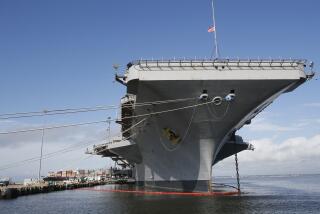Police May Never Learn What Motivated Gunman : Massacre: Hennard was seen as reclusive, belligerent. Officials are looking into possibility he hated women.
- Share via
KILLEEN, Tex. — After more than a day of combing through every piece of evidence they could find, police Thursday said they may never know what caused an unemployed former Merchant Marine seaman to crash his pickup truck into a cafeteria here and then systematically kill 22 people, the deadliest shooting spree in the nation’s history.
At the same time, a clearer picture began to emerge of George Jo Hennard, 35, a reclusive, belligerent man with an explosive temper who was drummed out of the Merchant Marine because of drug use. He was also painted by neighbors as a man who once stalked two young women who lived nearby, while police said they were also looking into the possibility that he hated women in general.
At a mid-afternoon press conference, Killeen Police Chief F. L. Giacomozzi said investigators had found no clues in the sprawling, 3,500-square foot home where Hennard lived in Belton, 15 miles from the slaying scene.
In addition to the 22 shot to death, 23 people were wounded in the rampage. At least 11 remained hospitalized Thursday, two in critical condition.
Wounded himself by police, Hennard put a 9-millimeter Glock 17 semiautomatic pistol to his head and killed himself.
Killeen, a town of 65,000 on the outskirts of Ft. Hood, in Central Texas, was in a state of shock Thursday. The death toll was more than twice as high as the 10 servicemen from Ft. Hood who died in combat in the Persian Gulf War.
Flags flew at half-staff. Counselors, clergy and volunteers tried to console residents. Luby’s Cafeteria remained roped off, but spectators stopped and stared at the scene. Hennard’s blue Ford pickup truck was removed before dawn.
Among the dead at Luby’s were school administrators and educators, a veterinarian, a career military officer, a woman who was treating her daughter and granddaughter to lunch and a woman from Missouri in town for a wedding.
“The whos, whats and whys we may never be able to figure out,” said Giacomozzi in what he said would be the last press conference on the slayings. “The reason we may never be able to find out is because Hennard is truly the only one who knows. He left behind nothing that we have found that would indicate he was going to do this.”
However, police did clear up several details. Giacomozzi had said earlier that Hennard still had bullets in his pistol and that quick action by police had prevented him from emptying all of the cartridges in the clips of his two pistols. On Thursday, the police chief said that in fact all six clips for Hennard’s two pistols were empty at the end of the rampage, indicating Hennard saved his last bullet for himself.
In a related issue, the police chief said the first policemen were on the scene one minute after the first call for help, contradicting statements by survivors that Hennard fired into the crowded cafeteria for 10 minutes before he shot himself. Giacomozzi also said that an autopsy was performed on Hennard at Parkland Memorial Hospital in Dallas and that he was shot by police four times in the chest, fell to the floor, rolled on to his back, looked at the ceiling and, police said, shot himself in the head.
Giacomozzi said Hennard “had an evident problem with women for some reason” and noted that of the victims, 14 of them were females. He said the only type of written communication found in the house were “like notes you write to yourself.” He did not elaborate, and also said that no drugs were found. Both guns, he said, were purchased last February and March in Henderson, Nev., and were registered with the Las Vegas police authorities.
In dozens of interviews with neighbors and other people who knew him, Hennard was almost universally described as a very difficult man who had spent much of his life wandering the world as a seaman. Two years ago, his Able-Bodied Seaman’s card was revoked by the Coast Guard after a bag of marijuana was found in his possession while on board the Green Wave on a return trip to the United States from Asia.
He appealed the revocation, but it was upheld last February when officials noted “by his own admission” Hennard had been “addicted to marijuana for a ‘long time” before being caught. The Coast Guard released Hennard’s appeals documents Thursday, which stated that he had undergone voluntary drug treatment at St. Joseph Hospital in Houston. Hennard claimed in his appeal that an unnamed psychiatrist had testified “that there would not be any danger to the public interest in putting appellant back on the ship.”
A spokeswoman for the hospital confirmed Thursday that Hennard had undergone treatment from July 14 to July 31, 1989.
“He came in voluntarily,” said Ellen Durckel, the hospital spokeswoman. “He reported smoking one or two (marijuana cigarettes) a day. The care was basically routine. He was discharged on an outpatient basis. There was no indication (in his records) of the kind of behavior he exhibited (Wednesday).”
The Coast Guard records also showed that his card was suspended for six months for kicking a crew mate and failing to obey the captain. He was also charged with possession of marijuana in El Paso in 1981, but was not convicted. Oddly, he changed his name in recent years from Georges Pierre Hennard to George Jo Hennard.
Isiah Williams, a branch agent for the National Maritime Union in Wilmington, Calif., described Hennard as “hyper, vindictive and always in a hurry.”
“He was very vindictive,” Williams said, explaining that when Hennard was on leave in San Pedro, Calif., he would often complain about other union members. “He always wanted to straighten out the score. He acted like he didn’t confide in anybody or trust in anybody.”
Pete Martinez, a union organizer, said that Hennard was “always a loner type around here. We didn’t know of him befriending anybody in San Pedro.” Hennard would often stay at the Hotel Cabrillo in San Pedro, where one hotel maid recalled that he was “kind of weird but nice. He always carried a backpack with him and never allowed anyone to touch it.”
Neighbors of Hennard in Belton said the mansion was often vacant, except for odd times when various family members would visit. Hennard’s father, Georges Hennard is an orthopedic surgeon in Houston. He said Thursday from his son’s home in Belton: “It was not drugs, that’s for sure.”
His mother, Jeanne, an antique dealer, lives in Henderson, Nev. She told the Dallas Morning News that she had spoken to her son on Tuesday, his birthday, and that he sounded fine.
“This is so frightening, so devastating,” the killer’s mother said from her home. “I don’t know what to do. I don’t know what to say. I’m interested in one thing: this tragedy and the death of my beautiful son.”
His parents were divorced in 1983. Hennard has two sisters.
Neighbors recalled a number of bizarre incidents in recent years in which the former seaman would be seen shouting and cursing at passersby.
One resident recalled how he yelled at a small boy who went looking for his baseball glove on the Hennard property. Another resident remembered how loud, hard rock music often reverberated from the large antebellum Hennard home, and whoever was staying there at the time would refuse to turn down the volume.
Geraldine Knight, a 79-year-old woman who lives two doors from Hennard, was amazed at how gingerly Hennard treated his blue pickup--the same vehicle he would use to smash through the cafeteria. “He took such good care of that truck,” she said. “I bet he washed it every day.”
But perhaps the oddest, and scariest, neighborhood episode occurred this past June when Hennard sent a five page, handwritten letter to two young sisters who lived two blocks away.
The sisters, Jana Jernigan, 19, and Jill Fritz, 23, said that the letter came at a time when Hennard seemed to be stalking them and their mother, Jane Bugg. They said he would drive by their house and wave, stop their cars when they came up the street, and even showed up at their places of work, or met them at local stores.
“He just kind of stepped back and looked at me for about 10 minutes,” said Jernigan, describing how Hennard suddenly showed up at the bank where she worked. “He had this big grin on his face. It was pretty awful.”
In the letter, he enclosed three photos of himself. He described women as “vipers” and said: “It’s very ironic about Belton, Tex. I found the best and worst in women there.”
He also wrote that he was “truly flattered knowing I had two teen-age groupies fans.”
“But unfortunately,” he added, “mommy dear had strong reservations about me. Maybe your mother saw me as the wolf in sheep’s clothing. Was she afraid I would act irresponsible with her two precious gems and then run and hide? Your mother made a miscalculation in her evaluation of me. There was no place to run or hide, then or now.”
He signed the letter, “Love you George, Your Fan George.”
The sisters complained that police, alerted about the letter and Hennard’s other behavior, never did anything. “There were never any cops patrolling this street,” Fritz said.
However, Capt. Cecil Cosper of the Belton Police Department said authorities never developed enough evidence to arrest Hennard for harassing the young women.
Cosper said that in May, a woman filed a disorderly conduct complaint against the former seaman after he had made an obscene gesture at her. In July, the Hennard family complained that an electronic “bug zapper” was stolen from their home. And last month, Hennard told police that someone was bugging his phone and calling at all hours, just to laugh and play music.
His home answering machine, on a newly listed phone number, gave this message: “Yo, Cuz. You’ve reached Public Street. Leave your name, number, time and message. Hang-up phone calls are absolutely prohibited and you’ll get bugged if you do so.”
Despite the odd behavior, Cosper insisted there was nothing about Hennard “to suggest he was capable of becoming a mass murderer. I don’t see how anybody can suggest that even if had been arrested (this past summer), it would have prevented this tragedy.”
Luby’s, a 151-restaurant chain popular with families and senior citizens, will keep the 45 employees in Killeen on the payroll, said the company president and chief executive officer, Pete Erben. No employees were among the dead.
No decision has been made about whether to reopen the cafeteria. A McDonald’s in San Ysidro, Calif., was closed within 48 hours of the 1984 shootings of 21 people, which until Wednesday was the worst mass shooting in U.S. history.
Texas Gov. Ann Richards said she would go to Killeen, but perhaps not until today, when she said a memorial service was scheduled.
Erben said that his company will contribute $100,000 to a relief fund and that San Antonio-based HEB Grocery Co. had agreed to donate $10,000.
Times staff writers Tracy Wood in Los Angeles, Hugo Martin in San Pedro and Lianne Hart in Killeen contributed to this story.
THE LUCKY ONES: Marveling at twists of fate. A14
More to Read
Sign up for Essential California
The most important California stories and recommendations in your inbox every morning.
You may occasionally receive promotional content from the Los Angeles Times.













